The Fabric: A Poet's Vesalius
Introduction
Some etymologists give the Greek "to see for oneself" as the source for the English word "autopsy." An alternative, "seeing into oneself," is hard to overlook when one studies the work of the sixteenth-century Belgian anatomist Vesalius. I gaze on these écorché figures with an exquisitely doubled (or divided) sense of looking.
Take the suffering skeleton (1), for instance. Very detailed, down to the tailbone, an excruciated figure: wailing away under the auspices of the clinician. But the artist has been at work in this presentation too. For the facts are mysteriously informed by feeling, and as the brain can make us feel, so too the heart can make us think.
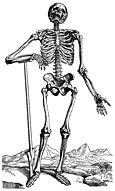 1
1Vesalius had his drawings done by Titian and his studio. (Some scholars attribute the work to only one artist, Calcar. For economy I'll refer to Titian himself, since I hold him responsible for his atelier.) There is some graphic footage here. The images rivet and reveal us as no list of facts could do. And the shocks are carnally compounded when (in the muscleman series) flesh adds its suggestiveness to gesture, yet overall, thanks to the depth of Titian's gifts, the images cannot remain merely voyeuristic.
Only a lifetime after Gutenberg died, Vesalius delivered to the printer for production and reproduction his De humani corpore fabrica, the extraordinary volume that contained these images and many more. What wows us in them now must once have wowed that printer too, the moment he laid eyes upon such beautifully belabored (and bedeviled) bodies, their lines and delineations studied to a fault. So carnal an exactitude! Even more than this work's forthrightness, its artifice assails us: the skeletons' figures are figured—down to the numbers of their fingertips, or, more precisely, down to the letters of their digits. And so they enter the realm where sign and design, science and art, conspire.
Drawn as surely to the drawn-and-printed as to the drawn-and-quartered figures (and as surely to the syntactics of the situations as to the semantics) I found I couldn't get enough of them. My senses fell to feasting. What exactly is that skeleton wailing over? As he mourns his lot, we see his lot is, not least, that one bit of real estate he's stuck on. His situation in time and space, unnatural though it is, moves us by analogy, or sympathy: we know, in time, we can't go back; he seems to know he can't go on.
However disposed we may be, in the face of such a foreground—in the face of such a face—to ignore the circumstantial background, nevertheless it bears regarding. (A casual eye is tempted away from it—as from those bowers and beaches of Victorian photographic studios, stylizations so conventional they lose the power to refer to anything but convention itself: their branches and waves seeming merely those of a weary imagination. But here the backdrop is no ordinary lover's lane. Our human being, our human has-been, stands on a bleak landscape, premises of hill and hole. He's either just come from, or is just now going toward, the very earth whose parts we tag for parts of our own anatomies: at the foot of a hill, at the mouth of a hole, this figure pauses to be figurative, and there to mourn the unrecoverable).
Much is not to be recovered in the realm of the suffering skeleton. Flesh, for example. Beckett says "tears are liquefied brain," and catches the pain in a language pan. This guy has cried his eyes out too.
The peaks and pits nearby appear reduced, by perspective, to the overlookable—the hill is barely knee-high, and the hole is hardly intimated. This skeleton's particular dugout (at the lower-left corner of the page) is one of the smallest features of the artist's rendering, but it may well be, in the purview of the wailing skeleton, one of the largest geophysical (or psychoactive) features around, a hole too big for him ever to fill. (As soon as the hole is finished, perhaps he'll have to occupy it . . . At last? Or again?) Perhaps then all his letters will migrate to a headstone.
You notice that Mr. Mort himself is equipped with a shovel, that armrest we at first glance might have taken for a branch or (more mortifying by far) a crutch. The shovel's head is improbably small, and its crossbar of handle is at right angles to that head; we might well not at first identify it as a digging tool. (Misprision, judiciously administered, can be indispensable to the protocols of art. At its best, it cannily administers the motions of the senses, makes a map of takings in, and of mistakings; a fever of identifications—first, false, and final. In the literary arts, the placements and displacements of our readerly regards can become a narrative of its own.)
Since a skeleton is itself a sort of apparatus of crutch and buttress, the shovel's shaft on first glance may well resemble a long bone, not only in shape and size but also in its involvement in the figure's posture—a proverbial third leg (subliminal allusion to the missing thrust so prominent in the flesh and consciousness of living men!). But then on second glance we realize: this is a shovel, not a body part, and this hapless figure seems to have dug his own grave. Or, sadder still, dug his way out of it. (After all, it's the image of no realistically fresh corpse on his way in. Because it isn't dripping flesh, this bone-man, though he seems to suffer, is far less troubling to the eye than are the Vesalian musclemen I'll look at soon, whose meat melts down from fingers and whose flesh is calving from their lower legs. It is flesh we find repellent, not bone. If cleanliness is next to godliness, rot is not. And nothing cleans a body up like dirt.)
So maybe this figure's wailing betokens a terrible disappointment at the world into which he has, again, so haplessly emerged.
Above the earth's own hills and holes, his unearthed pelvis hovers, in heavy lepidopterousness—an impression to which the recumbent skeleton, the naturalistic skeleton, would never give rise (there only the lowliest flies might have come to rest). Perhaps the exposed geologies of his own structure make us conscious of the hole-and-hill-work in the world. The pelvis (seat of so much heat and haunting, in a human life) has always made some mountains out of molehills—being itself a potent terrain for man's self-knowledge. (It's where knowledge got its hotter senses.)
Much of the power of this picture, taken as a whole, comes from a fundamental trope: the restoration of an animated attitude to the thought of bones—the skull and pelvis and patella marked by the human alphabet, and the kneeling and writing bones letter-bedeviled, letter-beset, as if it were language itself that had eaten the flesh away, as if even now a writer's pestilence of letters were attacking what is left of this suffering skeleton—the letters having, moreover, a particular taste for ligatures and joints. The semantics are antic; the syntax attacked.
Among readers, I suppose, poets are a materialistic sort. As soon as I detect the sign of the X at work, I'm near a buried treasure. (Hence the power of the figures of chiasmus.) You make the mark of the X because to elaborate—to literate—beyond that mark would dimish its meaning. How paltry or profane by comparison it is to write out the word "kiss," or the word "Christ," or in big black letters above the earth's own secret curves: SEE CHEST (or HEART) OF GOLD INSIDE. Take note: The bonds of such a materialism are deeply unconvertible: As an artist, I'm likely to love the X better than I love the gold. Or more precisely, for me there is no greater gold than that unexplicated X.
For as the logos becomes more and more explicated (through the successive ministrations of priests, philosophers, professor-postmodernists and PR men) more and more it loses for me the secret riches of its double nature. I'm talking language here, as much as anything, that logos—its capacity to radiate non-lexical senses. Perhaps that's why I am by nature a poet, and not someone more—well, more well-meaning.
The folio-feel of things, the crossfolds themselves, the quarto and verso of things, the physical implyings of the brain, not its big ideas, but its brooding broccoli, its coddled cauliflower, the mysteries of its material, lurking there in a brainpan—all mean more to me than any foistings of explainery. You can no more beard the world than make its meaning bald: no sooner prove a god to me than analyze an eagle. Yet eagles amaze us, alighted or aloft: and that gives us faith.
Let's not forget our shoveller. The bones don't seem to realize yet they're dead, or at least they haven't lost some living capacities to rue it. Meanwhile the shovel's head (what bites the dust) is peculiar in having a reinforcing or protective sheathe (something the skeleton himself no longer possesses). And the shovel is ready to undermine what a crutch might support. Leaning on the very instrument of its own engraving (ah, shades of penmanship!), this is a self-mourning, self-referring figure—i.e. the figure of art, figure of figures, with its ribs rigorously numbered and its companion, its comfort, its Eve, not apparently forthcoming: for this is the anatomist's art, and not the theologian's: of this man's ribs, not one is missing.
But he's missing almost everything else: and the feeling of loss is about him, heavy as stone. What metaphorically lumps in the throat, what wells up in the eye, what gets broken in the spirit, what drags the heart down—has its reality in the force of feeling, which brings to the subject's loss the object's weight. Our subject here becomes his own accusative.
This gravedigger faces skyward—of all the skeletons, he's the one who expresses the greatest inclination toward heaven, a figure who has been unearthed only to wind up grounded. If he's dug himself out, he's come to the place where he can't dig any further up—the air is all hole from there on out, and after the grave has been escaped, gravity will still keep him down. This poor soul cannot fly. He's looking up, but things are not.
And then (in the long now of a book) he's an object to be looked up. Unable even to die, he lives on, exposed to the view of those early medical students (who studied him once and who now bear him even more likeness, in structure if not in gesture), and lives on in our views as well; we too will die. Such is autopsy: it's yourself you're looking through, and at. The likeness that was buried in them as they regarded him is now buried in us as we regard him. (Inside every man of flesh is a man of bone just dying to escape.) The past we work to reassemble we'll resemble soon. With this handful of letters, we try to recover him—maybe even cover him up again. But we can't ever really recover from him.
What have I gotten into? the wailing skeleton seems to ask. (Figure of the long-suffering reader!) But also: What haven't I gotten out of? His nakedness is manifest and manifold—for the clothing of muscle, the fabric of nerve, the weave of arteries and veins are a carnal attire of which, layer by layer, Vesalius has elsewhere stripped him, in loving excruciation, in a kind of mortal tease.
By contrast the sidewise skeleton (2) seems calm and contemplative, the man of thought rather than the man of feeling. He's contemplating someone else's skull, his personal Yorick, and in one print of him there is inscribed, upon the stone sarcophagus or lectern, the words: Vivitur ingenio, caetera mortis erunt (Genius lives on, all else is mortal). He rests one hand upon the skull, perhaps affectionately, perhaps to keep it in its place. The foot is very lettered, which may be why I feel entitled to make my poet's reading of it. And there on the table, beside the skull he's contemplating, are bones from jaw and inner ear—poetry's parts. Half-turned away from us, the figure addresses an empty head, a numbskull. (Unlike his own, this skull is the merely mindless kind: it has no associated remains, no anima or matter to hook up with, no connections for making a gesture. In other words, the skull he contemplates is realistically dead—a noun alone: semantics without syntax, bone without brain. Only in life, or in art, may the parts cohere, conspire, aspire into a whole that's greater than their merely arithmetic sum.)
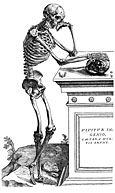 2
2In the second of the bone-man frames, there's no longer a hole in the ground. Instead there's a kind of Parnassus: the figure stands upon a high place, all else falls away, except the objects of his contemplation lying atop a solid structure which—if it's a sarcophagus—might otherwise have contained them. This bone-man is the cooler, perhaps more comic, figure; where the others have tensions, he has pretensions. An artist may make an altar of art while bringing some sarcasm to a sarcophagus.
After the second bone-man, his sidewise stance of an encomiast, we get the last, and posterior, skeletal figure (3). Where the middle one was distracted from his own condition, and stood in a high place, this one by contrast is most downcast, in the very attitude of sobbing. Unlike the gaze of the first frame's petitioner (which is toward heaven), this figure's attention seems fixed on the earth itself—where stands a pitiful lopped-off tree. Maybe that's what this bone-man mourns the most—that arboreal figure of life cut short (despite its promising little side-branch). Maybe it's the tenacity of life he grieves, as the tree survives. Maybe he's suffering Adam's punishment for sex (which was mortality). As a corpse, perhaps it is precisely sex he misses—he can't, after all (for all his bones) ever again have a boner.
Maybe he's the wisest of all the three: certainly he is the one most turned away from the likes of us.
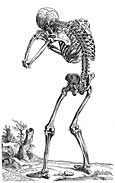 3
3There's plenty of tease in Vesalius's muscleman strips—a macabre combination of the comic, the erotic, and the horrific. Just cast a glance across the sequence of musclemen seen from behind (4)—they're nothing if not showy, with the strutting self-display and seductive gesticulation of models, hookers, pumpers of iron. Balletic yet self-mocking, pseudo-seductive, the next-to-last figure is visibly buckling in the right leg; the flesh hangs off in a grotesque parody of tattered clothing, and the knees are about to need the praying stone they'll get, just one frame later.
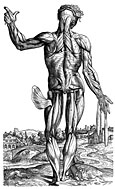
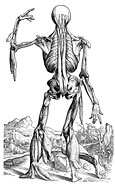
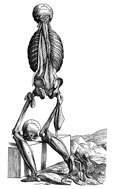 4
4That the brain, too, undergoes a striptease suggests its own gruesome humors: here the seat of thought and imagination, philosophy and poetry, is split, like any inferior seat (5). The moment you publish so literal an insight as this, the gulf between mind and brain is forever and humiliatingly revealed. These head-strips seem especially unnerving because what's on our minds, what's in our brains (usually considered in the figurative and facile sense, a mere gloss on everyday transactions) is here by contrast lugubriously literal: we asked for the lowdown on the seat of intellect and we got a den of worms; at best a higher intestine.
We are not used to treating mind as matter. We prefer to set the two apart, as contraries. But there, in harrowing artistic fidelity, just beneath the awful opened skull, are patches of an all-too-familiar face—an ear, a nose—and even (worst of all, because it suggests the flair of individuality, of style) that Lothario's moustache.
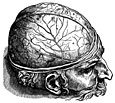
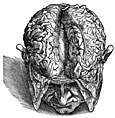 5
5Among body parts, faces are special cases. (In everyday commerce, they tell the most about the interior life of the emotions; in death it's especially unnerving to see them turned inside out.) The records tell us Vesalius got his heads from criminal executions; he needed them fast and fresh in order to make certain circulatory observations; the guys in these cranial and cerebral stripteases were more than figuratively hot.
In some Vesalian frames you see odd or floating body pieces, suspended above—or posed nearby—the central and coherent figures (which are by contrast clearly subject to the force of gravity). Above that most crucified of musclemen, for example (6C), floats what looks like some sea creature, skate or ray, almost a comment on the meaning of the current. (The musclemen's tale is one of some liquefactions, after all, since it drips with flesh, in time.)
This airborne oddity is a human diaphragm. (Hung up in air, the diaphragm's a structural reminder of the air that once was hung up in it.) Our most intimate parts come to the surface unforeseen, like gilled or underwater oddities: we don't recognize them because we do not know ourselves, no matter how sharp are the scalpels or saws, the lenses or legends, we bring to our occasion. (On occasion the subjective genitive overwhelms the objective genitive.)
In this same panel of the all-but-crucified muscleman, we get the single most gorgeous botanical detail we'll see up close in all Vesalius's offerings; under the diaphragm and hand (now dripping whole armlets of flesh) an exquisite flowering seems to thrive, embodying the gardener's law of exchange: decay for beauty, beauty for decay.
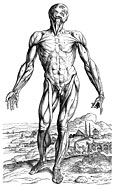

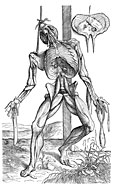 6
6In the progression even of just these three figures (6) I've used to exemplify the muscleman series, you can tell there's a clear program, as muscles are stripped away, layer by layer. As good readers we quickly grasp Vesalius's pedagogical arc, we see the meaning of the sequence: its inquiries move from outermost to innermost, by progressive incursion. (The excursive qualities in the landscape I'll treat later: but they do not enter into that first wallop of the visual impression.)
Most people will be shocked, at first look: in the transactions of everyday life, our innermost selves remain unexposed. We can't afford such insight—either about death, or, say, about the autonomic nervous system. (Thank the heavens something keeps us pumping through the night, so we can rest.) The ripping away of the veil, the violation of that integrity, especially in the muscleman sequence, where pieces of muscle hang like gaiters and gloves from deepening improprieties of flesh, feels sometimes painfully sexual.
The essence of this impropriety isn't moral: it's mortal. It occurs at the conjunction of the living pose and the fatal exposé: if this is a strip show, the seduction will come to its climax in gaping horror. Culminating the frontal series is a macabre carnage, in which the figure's bones are visible through its last scraps of flesh, as its skull and right shoulder are hoisted by a noose of rope (6C). Behind it is a wall whose shaded edge appears, to the casual glance, like the upright timber of a crucifixion scene. This illusion is carefully fostered: only at the ground, and half obscured by vegetative flourish, might the lateral line of a foundation be detected, and that line establishes the entire space of the right half of the panel to be a wall, not a sky.
But the proportions militate against our so identifying it: more than two-thirds of the panel—everything above the figure's knees (in short, the area we commonly take for central)—conspires to make the shaded area appear to be a wooden post. Only a scrupulous student of the arts of earth will gravitate toward that telltale line. If the heavenly gaze falls earthward, air will turn to stone, and the ray is nailed. But if the terrestrial gaze moves upward, stone turns air, and the ray flies free.
Of course that's an artist's lyric version of things. In the clinician's view, that item I'm calling a ray, as if it were some sun-spear or flying fish, remains a human organ. The two seers, let us call them Titian and Vesalius, collaborate in deepening and dividing our insight and our plight.
In the culminating illustration of the posterior musclemen series (4), the figure is abandoned by whatever spirit up until now made it able to stand and present itself in living postures: it falls to its knees upon a stone knee-rest. The musclemen at the end of the series need supports (whereas in most Vesalian poses even without skin or hearts or nervous systems, these pseudo-people are able to stand and gesture and display emotion)—so the effect is of a very strange natural science, with laws selectively pertaining to the animated dead. The sequences make narratives in which these dead figures too have life spans, and can decay. Even the dead can mourn. And even they must die.
Perhaps in Vesalius's Titian one most vividly sees the historical moment at which art branches off from theology—and realism from the realms of the original res, its theological ideal. To put it indelicately, this plate suggests a history of crucifixion images, but with a crucial difference: this guy (we think) won't rise again.
Of course the principal motive is clinical. Vesalius wanted to show how organs work in active figures, not reclining corpses. But we're aware in life we kill the lark if we should try to analyze the scrolls of music in it—so Titian's enterprise is as darkly ironic as brightly informative.
And even in these most grotesque of the excruciated musclemen there are signs of spirit. The hands' stripped skin and flesh suggest a melting materiality, a melting that leads the eye via gravity (through the downfall from the figure's fingers) into the vertical axis, axis of simultaneities, where it can dwell for a while out of the domain of the horizontal lines and historical progressions. (The vertical prevails again when gravity requires the final figure to be dragged up from above by rope and pulley. Perhaps, in the heaven of anatomy, God is the one with the winch.)
And indeed you can see a kind of wing on the second frontal figure (6B): look at the splay of muscle in the upper right arm which fans out just where, in other paintings of the time, you'd find an angel's most uplifting featherwork. (Elsewhere a muscleman sports the more Mercurial form of this wing, on one leg.) In the center frontwise muscleman, a phallic cross-section reveals what otherwise would have remained hidden by skin: a kind of clover shape or fig leaf in the patterns of a severance. Hints of higher and lower worlds are artfully inscribed in this, of all the panels: for the fig leaf which, in Genesis, would hide the skin is now shown in a perverse reversal to have been there all along, hidden by skin. Thus do mortal dilemmas becomes moral ones (like that of Chekhov's character who had too little skin to cover her face: in order to open her mouth she had to shut her eyes, and vice versa.) These are jokes that hurt, jokes that reveal. In our gapings, our apings, our flesh, how deep can a nakedness go?
Even while deeper and deeper inside information is revealed, wider and wider outside information unfolds. I've given you only selected panels, so you can't see the effect entire, but the landscapes behind these individual figures aren't repeated: they are continuous. The background terrain of the series, taken in the ensemble, forms a geographic panorama. Researchers have actually identified the stretch of Italian countryside to which this background scenery corresponded. Such circumstantial coherence proposes peculiar paradoxes: it requires us to consider whether the human figures are those of many men, or one.
For if our first impulse had been to see, in cinematic sequence, the successive stages of de-muscling in a single being, now instead (noticing the continuity of the landscape) we might be forced to think of them as different men all lined up in one moment. Time, too, is implicated: for if the lineup is of one man progressively stripped, then time must pass between shots, so he can move along the landscape's frame. Whereas if these are many men caught in a fortuitously progressive line of muscular disinvestiture, then the whole is a snapshot, not a moving image. Is it many still men, side by side; or over time a single man who moves? Is time a situation in which we're all engulfed together or a vector passing through each being's isolate experience?
This contest of interpretations manages to be reminiscent of some of the theological arguments of the time (is life one or many? is divinity concentrated or distributed? is it a material or a force?). To my mind the question catches something of a great unsolvability about our nature as living beings—about Being distributed through beings. (Is it a similarity that runs through all our differences? is it a differing that now and then falls into patterns of resemblance?) Thanks to the collaboration of Vesalius and Titian, we can't readily exclude either possibility. It isn't so much either/or as both. Not long after Vesalius was dead, Pascal would write, "the series of men may be considered as a single man, living forever, and continuously learning."
I'll end with only one more set of hints at my favorite twist of matter. (But I warn you: it's a twist like a Moebius strip. It's endlessness's twist.)
In the era of information technology, bedeviled and bedigited by a proliferation of facts and instances, its intellectual life reorganized along lines laid out by the instruments it creates, its lookers scanning stats, its oglers Googling globes, all in the game for an answering glance, all on the trail of that certain other one-and-onliness (doomed enterprise), even in such an era, the Era of Everything, there is something untallied. Or let's say there are two kinds of everything, two all-at-oncenesses.
One of the two is additive. Its piling up becomes occlusive, numbing, essentially mechanistic. The other is comprehensive. Its overlays are translucent, generative, essentially metaphysical. Where Kant discerned four kinds of Nothing, I propose (as an amateur in these realms) to distinguish only two kinds of everything. One everything is accomplished by the sheer patient summing up of all its component parts. (This sort of everything, when aimed for by technology, makes for amazing computations at amazing speeds. It is achieved at the ideal end of a pile of information, a sum beyond the capacity of a mind to contain it. It is instrumental, and indeed spreads instrumental diseases like wildfire, then has to adapt its own conceiving to create safeguards and search mechanisms sufficiently selective across a prolix, detail-bedeviled field.) Scholars, theorists, historians, mathematicians may be blessed with such gifts. To reach a given point, they build the road by which they get there—painstaking, legalistic, cumulative, horizontal.
Meanwhile the poet or intuiter, a metaphysician or feel-meister, will have fallen off a cliff, and reached the same point. A sudden vertical gets him there: an unforeseenness. The critic speaks of authorial intention; he thinks the artist means transitively. But the poet doesn't mean to mean: he writes to find out what he means, in some less transitive sense. In any sense in which an artist makes it, a seer's claim is not to a power, but to a vulnerability. Few would wish it: he must remain open to unbidden stimuli, suffer (without preconception or prescriptive filter) the sheer perceptual onrush. The second everything is of suddenness, not horizontal accumulation. It arrives in a slant of light, a snap of understanding across a field of patterns already richly there in a single moment's field. This other everything is holistic, not additive, as completeness is distinct from totality.
One feels for the facts in De humani corporis fabrica. The scientist's preparations deepen the satirist's sense of preposterousness; and the scientist's points become the artist's poignancies. In all these representations of the body, the place where least you feel the whole human being savaged, where least it seems reduced to the strutting stuff of a stripper's boudoir or the hoisted meat of the butcher's abattoir, and where the human figure seems not only whole but greatened somehow beyond mere sums of parts—is in the representations of the circulatory and the nervous system (7).
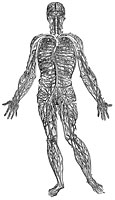
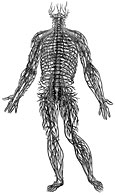 7
7The body's blood network wraps a man into his shape, keeps him bound in influences, fluencies. It is the tree of our family system, with one trunk and many branches and twigs curved about in interlocking bonds, a place of humming hammockwork. It's a comforting figure. When you look at circulatory man, you see why humans had to hug. But when you look at neural man, you see why humans had to fly.
For the nerve ends, taken altogether, make a complete human shape, while pointing with their flametips away from drags of gravity and heft, toward open air, as if into space. They make the man appear to be on fire, not so wrapped inward as circulatory man, but radiating outward, especially at loin and crown.
Despite etymology's insistence on a respiratory figure for spirit, it is rather the neural map, out of all the anatomical cartographies, that best matches our human intuitions of angelic form. The head is an aspiring crownwork, with its ring of flames upleapt; the meat is gone from mentality, and mens means mind again, in a way now clarified. Here in neural man the exposed mind turns out to be not a pitiable gaping of stuff or an unlidded cistern (as in all those autopsies of gray matter we saw before), not looping and self-centering but instead like our idea of an open mind, with its indicators pointing up and away from the self and the grave.
In Vesalius's work a cool, unflinching eye for physical truths meets Titian's hot, imaginative flair. Just where we might have feared that the inexpressibility of human being would be reduced to mere mechanics, or mere fancy, instead we find our attentions rewarded with a wealth of a spirited self-revelation, an extension rather than an abridging of the mysteries (mysteries which lie at the very heart—or maybe synapses—of our happening at all, in time and space). To my mind, the ultimate gift from Titian and Vesalius working together is the kind of evidence no mere theories of brotherhood, no willfulness of theology, can match. Revealed right there in graphic terms, both in the flesh and past it, are the matters that must matter most: blood's embrace, and nerve's release. You may be homely on the one hand, dying on the other, what remains is not to fear it. You can still look well. For what's beyond us is within us: look at the fact and the art, the mark and the remarking. There you'll have it: loving's fabric, and the evidence of spirit.
Images courtesy of Daniel Garrison, Malcom Hast, and Northwestern University. For more information about the Vesalius project, visit vesalius.northwestern.edu.
Poet Heather McHugh’s work is noted for its rhetorical gestures, sharp puns and interest in the materials of language itself—her self-described determination is “to follow every surge of language, every scrap and flotsam.” Describing her work in the Boston Review, poet and critic Richard Howard alleged that “most of McHugh’s poems end in a spurt, as they proceed in a slather, of just such astonishment...


